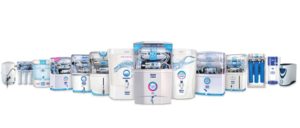Mahesh Gupta, founder and CEO, Kent RO, is working towards reaching revenues of Rs. 800 crore by FY 15

When Mahesh Gupta designed the first RO-based water purifier in 1999, he sold the product at Rs. 20, 000 as compared to his competitors, who priced their purifiers at Rs. 5, 000. Gupta justified his pricing with a strong conviction that the water purifier offered a superior technology and was the need of the hour among Indian consumers. That year, the company sold a meagre 100 units and recorded a revenue of Rs. 12 lakh. Today, well over a decade since its inception, Kent RO holds a 40 per cent share in the Rs. 3, 000 crore water purifier market in India and sells over 4, 00, 000 units a year, from its facilities at Roorke and Noida.
When we last spoke to Gupta in May 2012, the company had in its stable, several models of water purifiers, such as Kent Grand and Kent Pearl, which were priced between Rs. 13, 000 to Rs. 17, 000. In April 2013, it launched Kent Premium, which offers zero per cent water wastage in RO purifiers. “Traditional RO purifiers cause 80 per cent of the water to be rejected and just 20 per cent to be purified and recovered. We have developed a computer controlled patented technology which ensures that more than 50 per cent of the water intake is recovered as purified water,” says Gupta. The balance rejected water is stored in a separate reject water tank, which can be utilised by consumers for household purposes.
While Kent’s vegetable and fruit purifiers, air purifiers and water purifiers have recorded good sales since 2012, Gupta indicates that the company’s main growth was seen in the water purifier segment. In FY13, it recorded a turnover of Rs. 450 crore and aims to reach the Rs. 800 crore mark by FY15.
Going glocal
In June 2013, Kent RO entered into a strategic partnership with the international water purifier brand, Electrolux. The nature of the partnership is such that Kent RO will adopt its home-grown technology to manufacture market and distribute Electrolux water purifiers in India and in turn, Electrolux will promote and sell Kent RO water purifiers in the international markets.
“If a television stops working, you can wait for a day or two to repair it, but when a water purifier does, you want it to be repaired in four to eight hours. For me, the challenge lies in getting it repaired within this time period.”
Gupta firmly believes that this partnership will not result in cannibalisation of its own water purifiers in India and instead, offer dual benefits to the company. Firstly, he indicates that the water purifiers manufactured under the Electrolux brand will be designed to create an aesthetic appeal in Indian kitchens. Secondly, Kent RO will piggy back on the Electrolux brand, to gain an international reach for its products. “We cannot do this by ourselves because we do not have the required distribution network. This is where Electrolux’s expertise and reach will come into play,” states Gupta.
The company has introduced two water purifiers under this partnership; Electrolux Vogue and Electrolux Sterling. While the former will be available for Rs. 18, 000, the latter will be priced at Rs. 19, 000. In this first year, the company plans to establish distribution for Electrolux in 50 top towns across the country. It aims to sell 50,000 units of the Electrolux range of water purifiers in FY14 and expects to grow at 25 per cent year-on-year after that. “We have taken a different route for Electrolux where our primary target audience will be the elite class. We will also be having a different distributor network and to begin with, we will have 100 distributors on ground,” says Gupta.
Additionally, in a move to capture the untapped tier-II and tier-III segments across India, in March 2013, Kent RO launched Kent Gold series, a range of entry-level water purifiers, priced between Rs. 1, 400 and Rs. 2, 500.
Building multiple marketing strategies
Gupta believes in adopting a combination of print, television and radio advertising and the franchisee route, to educate consumers about the purifiers. While he has focussed on print advertisements for this fiscal, on the franchisee front, the company has setup 50 exclusive Kent Shopee outlets, which will display an array of Kent’s products and give the consumer an opportunity to experience and gain awareness about its product range.
He goes on to indicate that after-sales service is also one of the most important aspects in building the Kent brand. “If a television knocks off, you can wait for a day or two to repair it, but when a water purifier does, you want it to be repaired in four to eight hours. For me, the challenge lies in getting it repaired in this time period,” explains Gupta. The company is trying to achieve this by increasing the number of service franchisees and service manpower. “Of the 50 franchisee outlets we have setup, some of them are exclusively into after-sales service only, whereas some offer direct sales as well as after-sales service,” he adds.
Educating consumers
Despite the water purifier market being crowded with multiple players such as Hindustan Lever’s PureIt, Eureka Forbes’s Aquaguard and Kent RO, the biggest challenge that Gupta has faced since the beginning, right until today, is educating consumers about the importance of having a water purifier at home. “It is not like the government is taking giant strides towards providing clean drinking water to the public. Till that happens, the water purifier market will continue to grow and the need for purifiers will increase,” states Gupta.
Moreover, he indicates that despite having a wide distribution network, the company still struggles to achieve a pan-India penetration. “Education does not happen at the point of sale. Thus, we are trying to employ more on-ground salespersons to connect directly with the consumers and tell them about our products,” he says.
Going forward
The company is witnessing a healthy CAGR of 30 per cent every year and expects to continue to grow at this pace in the coming years. While it recorded a revenue of Rs. 450 crore in FY 13, it aims to reach the Rs. 600 crore in the next fiscal and Rs. 800 crore by FY 15. “All in all, my vision for the near future is to provide clean drinking water to every household across the country,” says Gupta, as he signs off.
| Then | Now |
| Turnover of Rs. 331 crore | Turnover of Rs. 450 crore |
| Four manufacturing plants in Roorke | Additional plant setup in Noida |
| Increased distribution network and strengthened traction pan-India | Launched Kent Premium for regular customers and Kent Gold Series for tier-II/ tier-III regions, partnered with Electrolux to introduce water purifiers for elite class, aims to create global reach through Electrolux |
| Launch exclusive retail shops in the next two years | Setup 50 Kent Shopee outlets in FY 13 |
STARTUP SCHOOL WITH MAHESH GUPTA, FOUNDER, KENT RO
Kent RO is the second entrepreneurial venture for Mahesh Gupta. After working for a little over a decade in Indian Oil Corporation, he founded SS Engineering (which he still heads), a company that tests and conserves petroleum products. In 1999, when his children fell ill due to water contamination, he began experimenting with water purifiers and pioneered in developing an RO purification system. Today, well over a decade after building a Rs. 450 crore company from scratch, Gupta shares vital lessons from his successful trials with identifying, manufacturing, marketing and selling the Kent range of water purifiers to Indian consumers.
Playing against the odds
In 1999, when players such as Aquaguard were selling their water purifiers at Rs. 5, 000 and competing for a larger market share, Gupta, with no prior experience in this segment, put the country’s first RO-based water purifier, out in the market, for a hefty price of Rs. 20,000. Here, he shares the tactics he adopted to stand against such competition and build a successful company:
It is of utmost importance to have confidence in the product you are selling. That confidence can also be elevated from the feedback you receive from your customers. For instance, if they find good value for money from the product, success will automatically follow.
Secondly, it is important to constantly innovate based on market and customer feedback. For instance, when we launched our first purifier, we created one that can be installed under the counter. When we found that it wasn’t feasible, we followed international standards and created one that can be installed on kitchen tops. This failed too, because Indians generally have the tendency to wash the kitchen counters at least once a day. As a third attempt, we launched wall mounted purifiers and that became a huge success. From this, we learnt that it is very crucial to listen to what your customers are saying and that reduces failures to a large extent, if not completely.
A third challenge we faced during this period was lack of brand awareness. While initially, we sold only through word-of-mouth, in 2005, we realised that unless we reach out to the masses and create greater awareness, we may not get the desired return on investment. That’s when we launched our first television advertisement with actress Hema Malini. Eventually our consumers realised that we were investing money in building the brand and it gained popularity overtime.

It takes two to tango
For companies like Kent RO, establishing and maintaining good relationships with the distributor and vendor network is crucial to achieving higher sales and reach for its products. Here, Gupta shares some lessons on how companies can maintain a cordial relationship with these networks:
Firstly, you need to be completely honest and fair when negotiating with your network. I make it a point to always tell my co-workers that even if they’ve made a loose commitment, even if it creates a loss for us, they should go ahead and honour it.
Secondly, you need to be transparent in your dealings, especially in financial aspects. At the very beginning, I designed a company policy which strictly prohibited cash transactions. I ensured that every transaction was made above par, on a billing basis and every amount was paid in cheque. This helped us gain tremendous vendor trust. The process is so deeply ingrained in our system that even today; nobody comes and asks us for discounts or cash redemptions.
Thirdly, you must always ensure that your network makes profit. You have to design policies that add value to their margins and cover their expenses to an extent because if the network doesn’t make money, they are not going to stick to you. This leads us to the question, how do we price our product? For instance, if you price it at the lowest point, where the distributor doesn’t get any margin and all margins pass on to the consumer, it will affect your business. Vendors play a crucial role in educating the consumers about our products and making our product popular or in other words, they add value to the system and you have to pay for that value. So, it’s important to ensure that they make good margins. In fact, even today, when I meet my vendors for an annual review, I make it a point to ask them, have you made good profits last year?
Lastly, you should always pull consumers towards your products and not push it to them. While the latter will lead you to a place where you have to give them discounts, the former will make the consumer and even your vendor realise your brand value and brand standing. And this will help build the brand confidence amongst your network.
Overcoming hurdles
Here, Gupta shares his experiences on the two biggest challenges he faced, in over a decade of building Kent RO, and how he tackled them:
Our first big challenge was in recruiting quality manpower during the early phase of the company. At that time, neither did we have a good brand presence, nor were our company policies in place. Essentially, we took a risk by hiring manpower we could afford, training them and getting the best out of them.
A second challenge we faced was in creating brand credibility in the consumer’s mind. While I knew I had a good product to offer, the consumers wouldn’t believe me because we hardly had any brand presence and our product was priced significantly higher than our competitors’. To tackle this, through our network of direct salespeople, vendors and through mass media, we decided to adopt a dual strategy of educating our consumers about the importance of having a water purifier at home, telling them what parameters they need to take into consideration when buying a water purifier and most importantly, creating an emotional connect with them. Today, seven years hence, because of the time consuming value proposition we built for our brand, we have close to a million customers using our products. But, ask any of them today, why they believe Kent provides pure water and they only say, we tested the product and found it to be good.
Stand on your own feet
Since inception, Gupta was clear that he did not want to seek external funding. He ensured that he relied on internal accruals for growth. Here, he shares some insights on how entrepreneurs can build a self sustaining business.
Today, by the close of this fiscal, we will be a Rs. 600 crore company. However, if we had sought external funding, we could’ve touched the Rs. 1, 200 crore mark in no time because that is the kind of potential this market holds. But, I strongly believe that one should work within their limits because as a small company you never know when you’re going to face a bad time. At the same time, when I want to venture into risky areas, I always insist on evaluating my risk and going ahead only when I have something to fall back on.

